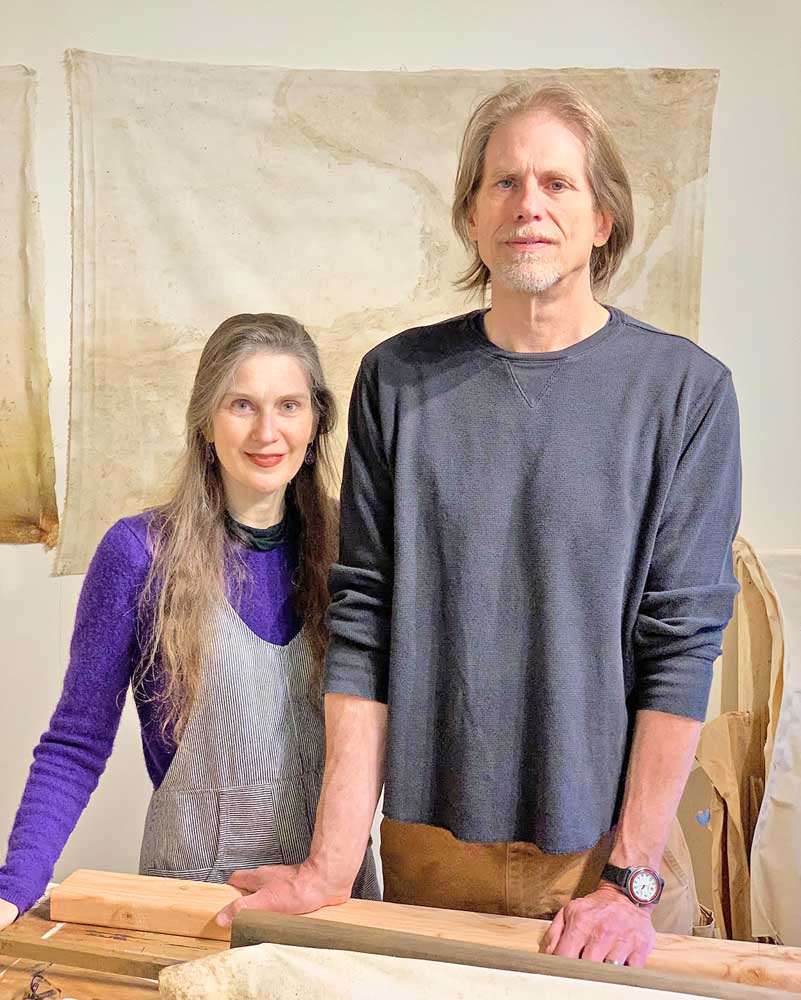‘Swamp Concerto’ creates art from nature: Exhibit highlights delicate Grays River ecosystem
Published 9:58 am Wednesday, April 3, 2024

- Anna Daedalus and Kerry Davis moved from Portland to Grays River in 2019 and have been busily documenting the ecosystem of the 55 acres of restored Sitka spruce swamp protected by the Columbia Land Trust. They have put together an unusual art exhibit, timed to coincide with Earth Day April 22. It will be displayed at the Astoria Visual Arts gallery from April 13 to May 5.
A couple who live next to a delicate Lower Columbia River ecosystem have found a way to highlight its importance through art.
Anna Daedalus and Kerry Davis will display their unusual designs at an exhibit in Astoria opening this weekend.
“Swamp Concerto”
Art from the environment by Anna Daedalus and Kerry Davis
Astoria Visual Arts gallery, 1000 Duane St., Astoria
Opening Saturday, April 13. Artist talk at 3 p.m. and reception from 4 p.m. to 7 p.m. On view through May 5 11a.m. to 3 p.m. Fridays and Saturday.
For information visit astoriavisualarts.org.
For details of the artists’ other work, visit annadaedalus.com and kerrydavisart.com.
“Swamp Concerto” will be featured at the Astoria Visual Arts gallery at 1000 Duane St. in downtown Astoria. It highlights art created by the Mill Road site of Columbia Land Trust’s Grays River project, a crucial ecosystem for coho, Chinook, chum, and steelhead.
The exhibit opens Saturday, April 13 with a talk by the artists at 3 p.m. and reception from 4 p.m. to 7 p.m. The show is then on view through May 5, although the gallery is only open to the public 11a.m. to 3 p.m. Fridays and Saturdays.
Annie Eskelin, the gallery’s executive director, is intrigued by the project, and its hands-on approach to the wetland ecosystem. “These projects foreground physical, tactile experience and the ideas of presence and immediacy,” she said. “The living water, weather and plants mark the materials, leaving tangible traces of their presence.”
The couple has spent three years observing the wetland through outdoor installations and time-based processes. “Swamp Concerto” will include photographic prints, artists’ books and canvases. The exhibit draws on three projects: Palus (2021), Grounded Glass (2022) and Decomposure (2023-24). All focus on a protected Sitka spruce swamp, an environment that supports food webs, lowers water temperature, captures sediment and absorbs floodwater.
Storied swamp
The exhibit offers several elements:
• “Palus” (Latin for swamp) is a meditation on the swamp’s movements featuring Torii Tidal Screens, outdoor installations of 4-foot by 5-foot canvas screens marked by rising tide waters. The artists say that in form and function the screens evoke Shinto gates which mark the transition from the mundane to the sacred.
• “Grounded Glass” is series of photographs that focus on the muddy matter in the swamp’s tidal flow, allowing the swamp to build up layers of caked mud on glass plates.
• “Decomposure” documents the interrelated processes of growth and decay with photographs and canvases, which the artists describe as “uneasy compositions speak to perceived aesthetic and biological value.”
Also on view are handmade artist books of prints using skunk cabbage, salmonberries and other plants to create contact prints of foliage like horsetail, red elderberry and willow.
‘Grateful’
Davis studied photography and filmmaking at Portland State University and the Oregon College of Art and Craft. He said he has enjoyed the artistic collaboration with his wife to document a significant and threatened, regional environment.
“Being creatively productive about issues that matter and then sharing that work with others is extremely satisfying,” he said. “Through the collaborative and experimental process of this work, I have had the benefit of becoming more intimate with and mindful of the wetland environment of the Lower Columbia River Estuary.”
Daedalus earned her bachelor’s degree from Reed College. She has enjoyed the slower pace of the project, which she described as “more about dialogue and process than controlled outcomes.”
“Our multifaceted approach is mirrored by the tidal wetland setting itself, which is in continual flux through the hours and the seasons,” she noted. “All these varying elements have brought unpredictable, dynamic energy to the project and made the process thoroughly engaging.”
There is another joy, too.
“From an ecological standpoint, it is a delight to watch and listen to the many comings and goings of the birds, fish, mammals, insects, blossoms, berries and trees who create the storied swamp,” she added. “I am grateful that these projects have made me more attentive to this protected place.”
‘Complex’The art project has enthusiastic support from Austin Tomlinson, coast region stewardship manager for the Vancouver-based land trust.
“The landscape that inspired Anna and Kerry’s art is a 55-acre Sitka spruce swamp near the Grays River that Columbia Land Trust conserved in 2004 and restored in 2011,” Tomlinson said. “This project improved habitat for juvenile salmon and reconnected the river to its natural floodplain.
“Throughout the coastal region, Columbia Land Trust works to protect older forests, increase the prevalence of tidal wetlands, manage invasive species and restore salmon habitat, among other conservation objectives. Fostering connections between people and nature is central to our mission, so we enjoy seeing unique art like this that is inspired by the beautiful place we live.”









